6AG528 Research Methods Assignment: Ethics and Data Analysis Report
VerifiedAdded on 2023/03/30
|31
|5563
|410
Report
AI Summary
This document presents a comprehensive solution to a research methods assignment, addressing ethical considerations in research and data analysis. The assignment begins with a scenario involving a company's employee satisfaction survey, highlighting ethical issues such as lack of informed consent, confidentiality breaches, and potential for coercion. The solution emphasizes the importance of adhering to ethical codes of conduct, including informed consent, beneficence, respect for privacy, researcher skills, and protection of integrity. The document further explores both quantitative and qualitative data analysis techniques, using descriptive analysis to interpret data on employee satisfaction. The analysis includes detailed tables and charts, providing insights into the mean, median, mode, standard deviation, and other statistical measures. The assignment also includes specific data responses from employees to questions related to job satisfaction and other company-related issues. Overall, the assignment provides a practical application of research methodologies, emphasizing ethical considerations and data interpretation within an organizational context.
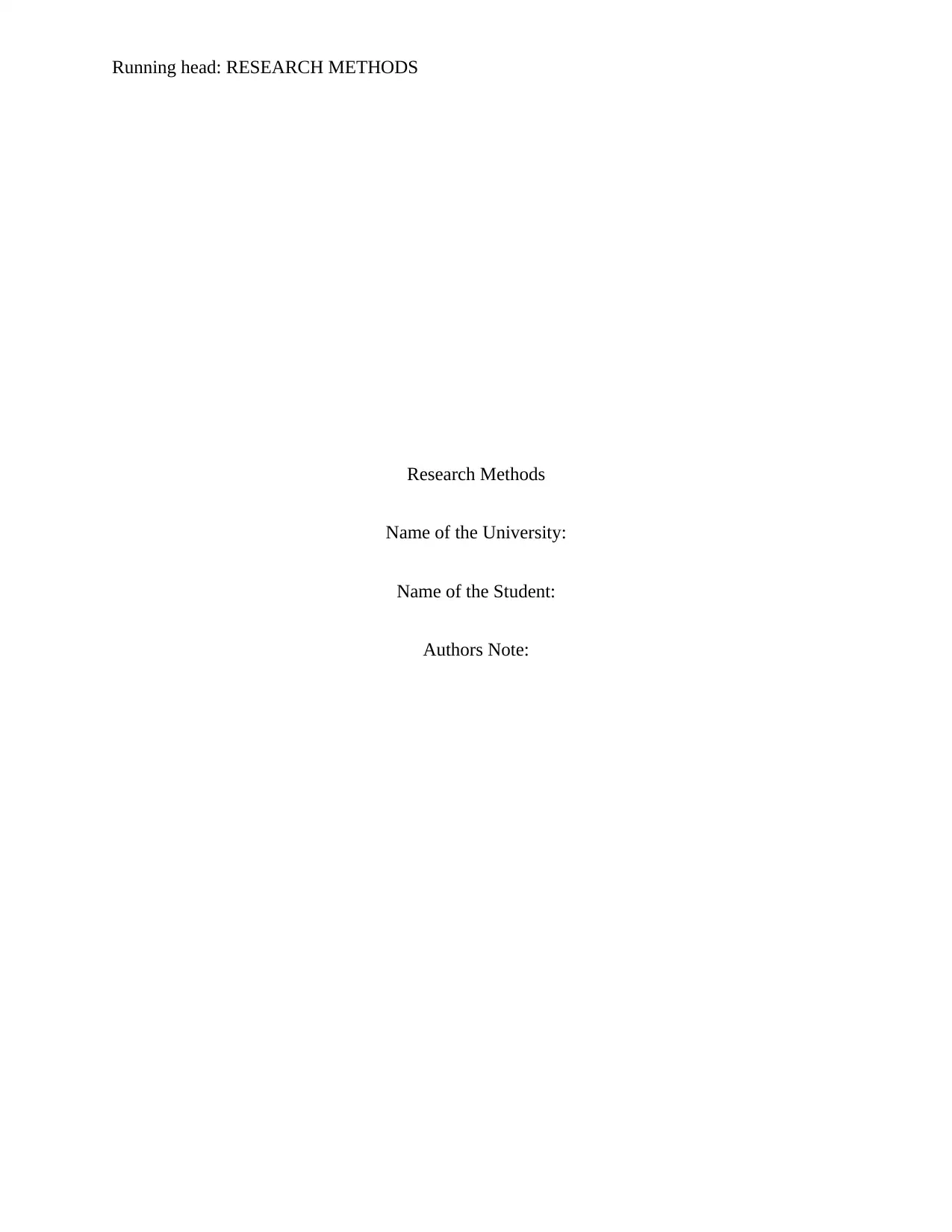
Running head: RESEARCH METHODS
Research Methods
Name of the University:
Name of the Student:
Authors Note:
Research Methods
Name of the University:
Name of the Student:
Authors Note:
Paraphrase This Document
Need a fresh take? Get an instant paraphrase of this document with our AI Paraphraser
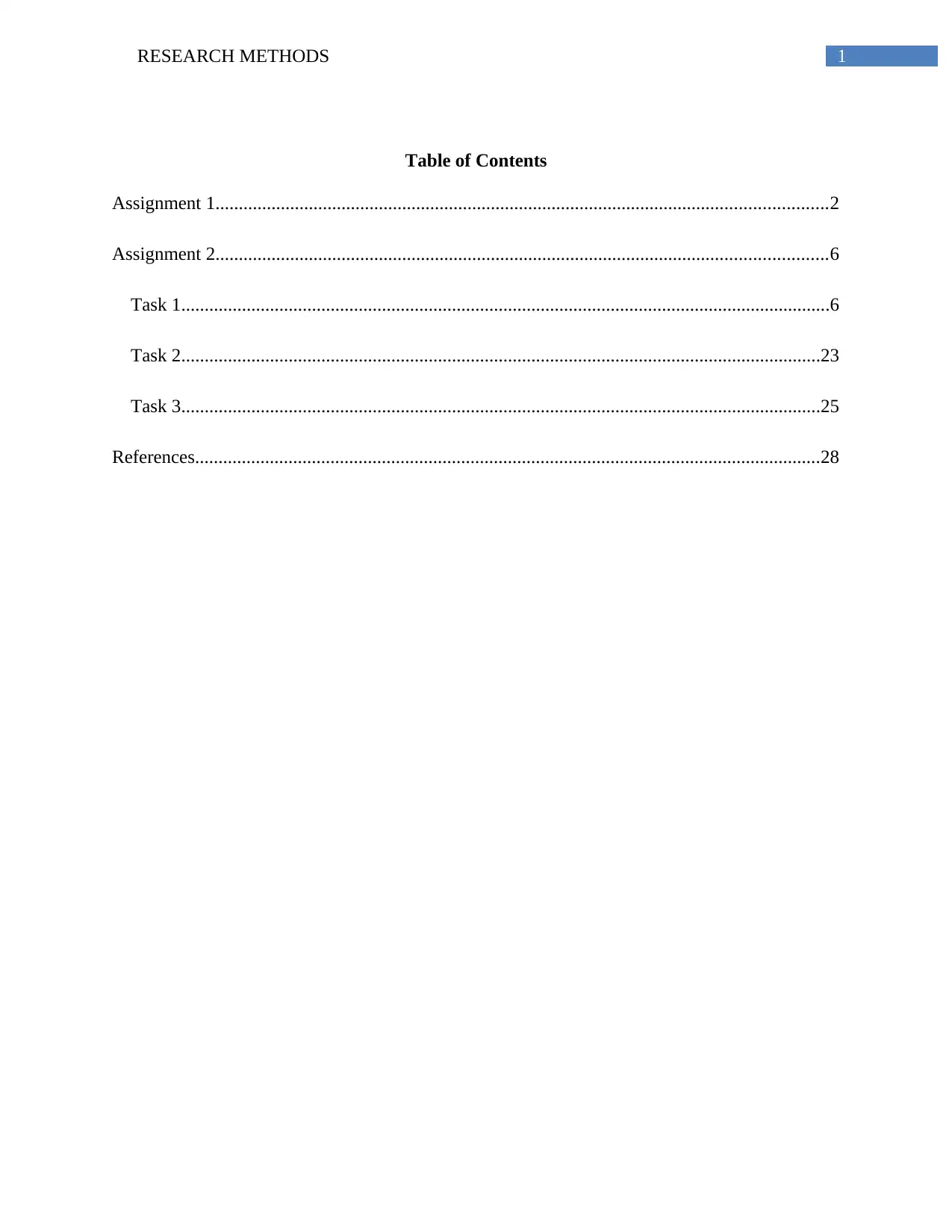
1RESEARCH METHODS
Table of Contents
Assignment 1...................................................................................................................................2
Assignment 2...................................................................................................................................6
Task 1...........................................................................................................................................6
Task 2.........................................................................................................................................23
Task 3.........................................................................................................................................25
References......................................................................................................................................28
Table of Contents
Assignment 1...................................................................................................................................2
Assignment 2...................................................................................................................................6
Task 1...........................................................................................................................................6
Task 2.........................................................................................................................................23
Task 3.........................................................................................................................................25
References......................................................................................................................................28
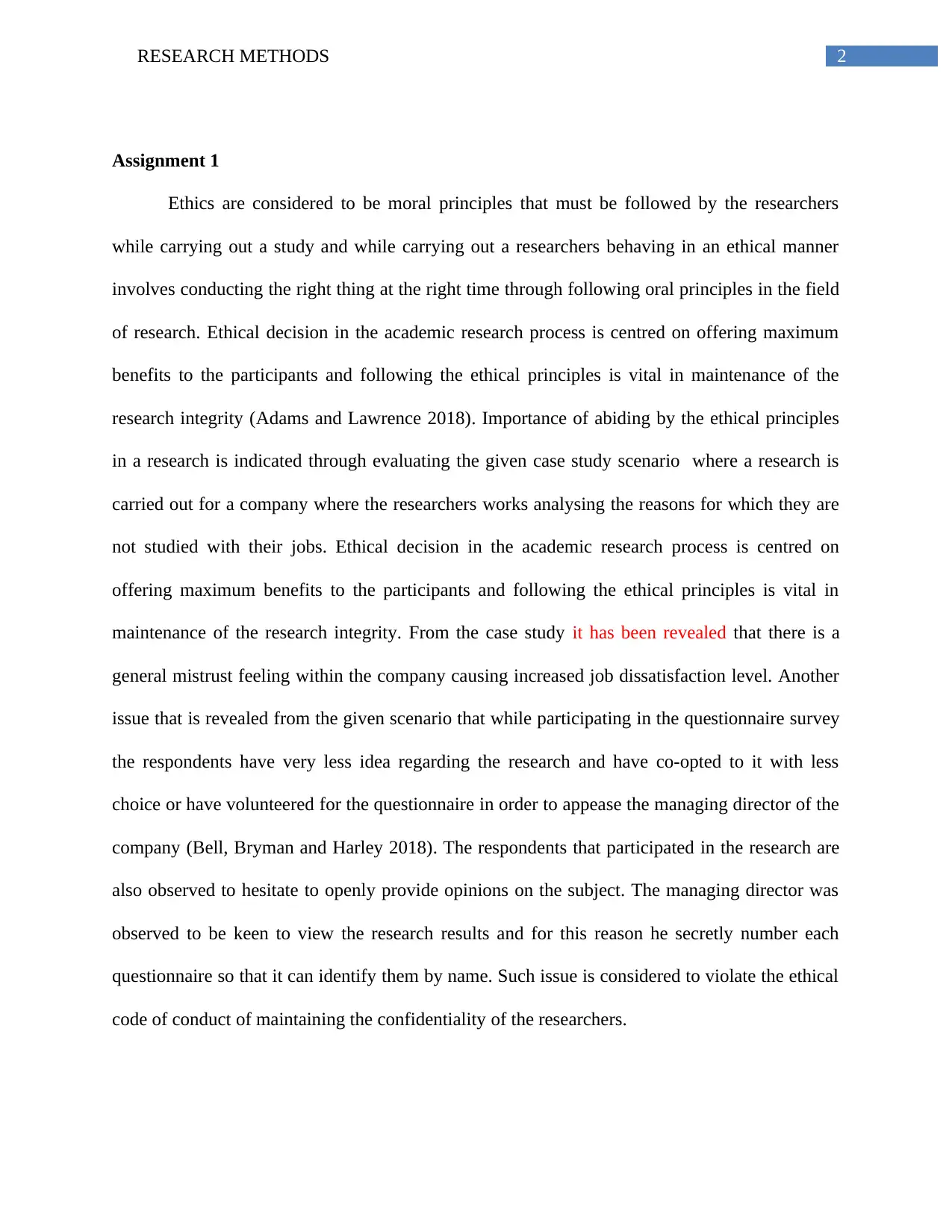
2RESEARCH METHODS
Assignment 1
Ethics are considered to be moral principles that must be followed by the researchers
while carrying out a study and while carrying out a researchers behaving in an ethical manner
involves conducting the right thing at the right time through following oral principles in the field
of research. Ethical decision in the academic research process is centred on offering maximum
benefits to the participants and following the ethical principles is vital in maintenance of the
research integrity (Adams and Lawrence 2018). Importance of abiding by the ethical principles
in a research is indicated through evaluating the given case study scenario where a research is
carried out for a company where the researchers works analysing the reasons for which they are
not studied with their jobs. Ethical decision in the academic research process is centred on
offering maximum benefits to the participants and following the ethical principles is vital in
maintenance of the research integrity. From the case study it has been revealed that there is a
general mistrust feeling within the company causing increased job dissatisfaction level. Another
issue that is revealed from the given scenario that while participating in the questionnaire survey
the respondents have very less idea regarding the research and have co-opted to it with less
choice or have volunteered for the questionnaire in order to appease the managing director of the
company (Bell, Bryman and Harley 2018). The respondents that participated in the research are
also observed to hesitate to openly provide opinions on the subject. The managing director was
observed to be keen to view the research results and for this reason he secretly number each
questionnaire so that it can identify them by name. Such issue is considered to violate the ethical
code of conduct of maintaining the confidentiality of the researchers.
Assignment 1
Ethics are considered to be moral principles that must be followed by the researchers
while carrying out a study and while carrying out a researchers behaving in an ethical manner
involves conducting the right thing at the right time through following oral principles in the field
of research. Ethical decision in the academic research process is centred on offering maximum
benefits to the participants and following the ethical principles is vital in maintenance of the
research integrity (Adams and Lawrence 2018). Importance of abiding by the ethical principles
in a research is indicated through evaluating the given case study scenario where a research is
carried out for a company where the researchers works analysing the reasons for which they are
not studied with their jobs. Ethical decision in the academic research process is centred on
offering maximum benefits to the participants and following the ethical principles is vital in
maintenance of the research integrity. From the case study it has been revealed that there is a
general mistrust feeling within the company causing increased job dissatisfaction level. Another
issue that is revealed from the given scenario that while participating in the questionnaire survey
the respondents have very less idea regarding the research and have co-opted to it with less
choice or have volunteered for the questionnaire in order to appease the managing director of the
company (Bell, Bryman and Harley 2018). The respondents that participated in the research are
also observed to hesitate to openly provide opinions on the subject. The managing director was
observed to be keen to view the research results and for this reason he secretly number each
questionnaire so that it can identify them by name. Such issue is considered to violate the ethical
code of conduct of maintaining the confidentiality of the researchers.
⊘ This is a preview!⊘
Do you want full access?
Subscribe today to unlock all pages.

Trusted by 1+ million students worldwide
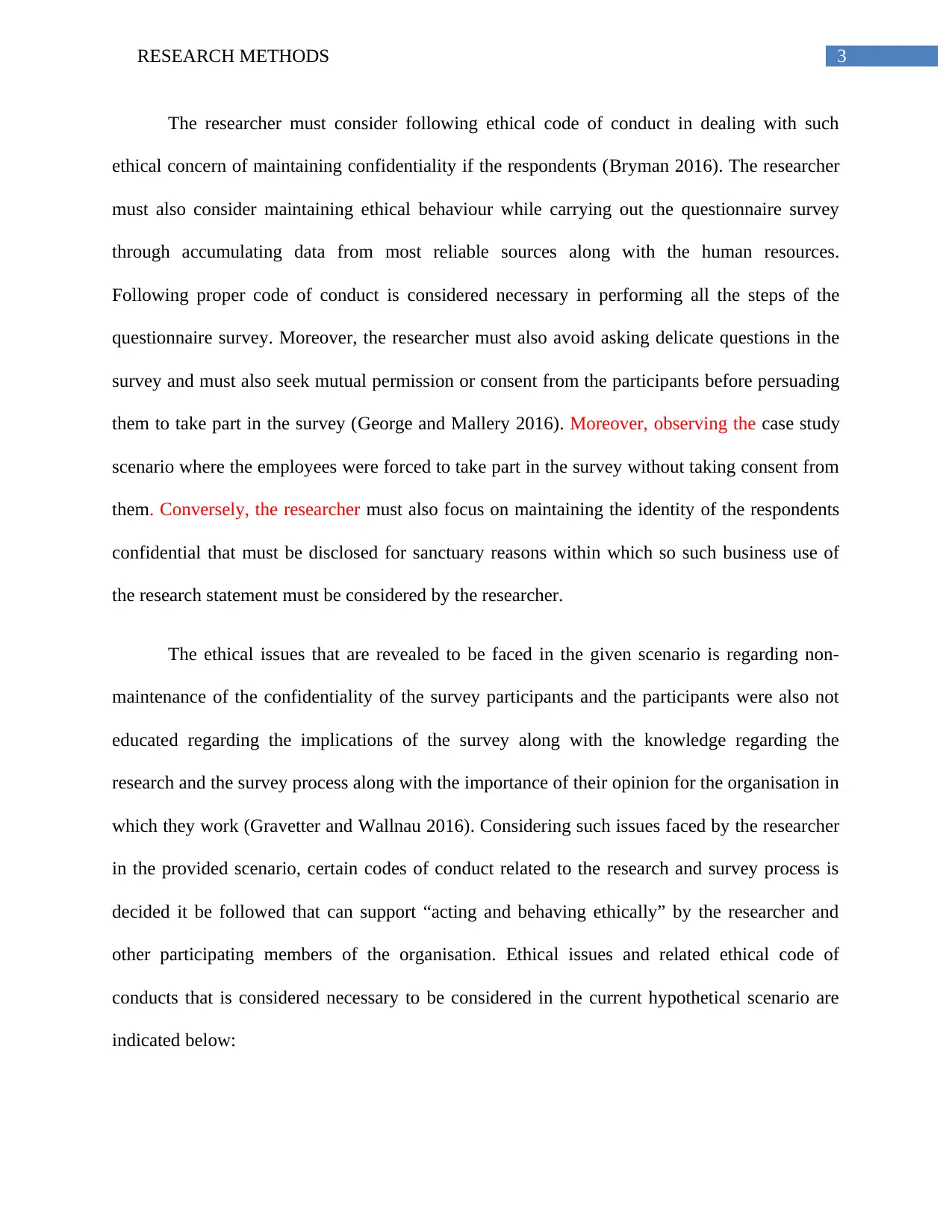
3RESEARCH METHODS
The researcher must consider following ethical code of conduct in dealing with such
ethical concern of maintaining confidentiality if the respondents (Bryman 2016). The researcher
must also consider maintaining ethical behaviour while carrying out the questionnaire survey
through accumulating data from most reliable sources along with the human resources.
Following proper code of conduct is considered necessary in performing all the steps of the
questionnaire survey. Moreover, the researcher must also avoid asking delicate questions in the
survey and must also seek mutual permission or consent from the participants before persuading
them to take part in the survey (George and Mallery 2016). Moreover, observing the case study
scenario where the employees were forced to take part in the survey without taking consent from
them. Conversely, the researcher must also focus on maintaining the identity of the respondents
confidential that must be disclosed for sanctuary reasons within which so such business use of
the research statement must be considered by the researcher.
The ethical issues that are revealed to be faced in the given scenario is regarding non-
maintenance of the confidentiality of the survey participants and the participants were also not
educated regarding the implications of the survey along with the knowledge regarding the
research and the survey process along with the importance of their opinion for the organisation in
which they work (Gravetter and Wallnau 2016). Considering such issues faced by the researcher
in the provided scenario, certain codes of conduct related to the research and survey process is
decided it be followed that can support “acting and behaving ethically” by the researcher and
other participating members of the organisation. Ethical issues and related ethical code of
conducts that is considered necessary to be considered in the current hypothetical scenario are
indicated below:
The researcher must consider following ethical code of conduct in dealing with such
ethical concern of maintaining confidentiality if the respondents (Bryman 2016). The researcher
must also consider maintaining ethical behaviour while carrying out the questionnaire survey
through accumulating data from most reliable sources along with the human resources.
Following proper code of conduct is considered necessary in performing all the steps of the
questionnaire survey. Moreover, the researcher must also avoid asking delicate questions in the
survey and must also seek mutual permission or consent from the participants before persuading
them to take part in the survey (George and Mallery 2016). Moreover, observing the case study
scenario where the employees were forced to take part in the survey without taking consent from
them. Conversely, the researcher must also focus on maintaining the identity of the respondents
confidential that must be disclosed for sanctuary reasons within which so such business use of
the research statement must be considered by the researcher.
The ethical issues that are revealed to be faced in the given scenario is regarding non-
maintenance of the confidentiality of the survey participants and the participants were also not
educated regarding the implications of the survey along with the knowledge regarding the
research and the survey process along with the importance of their opinion for the organisation in
which they work (Gravetter and Wallnau 2016). Considering such issues faced by the researcher
in the provided scenario, certain codes of conduct related to the research and survey process is
decided it be followed that can support “acting and behaving ethically” by the researcher and
other participating members of the organisation. Ethical issues and related ethical code of
conducts that is considered necessary to be considered in the current hypothetical scenario are
indicated below:
Paraphrase This Document
Need a fresh take? Get an instant paraphrase of this document with our AI Paraphraser
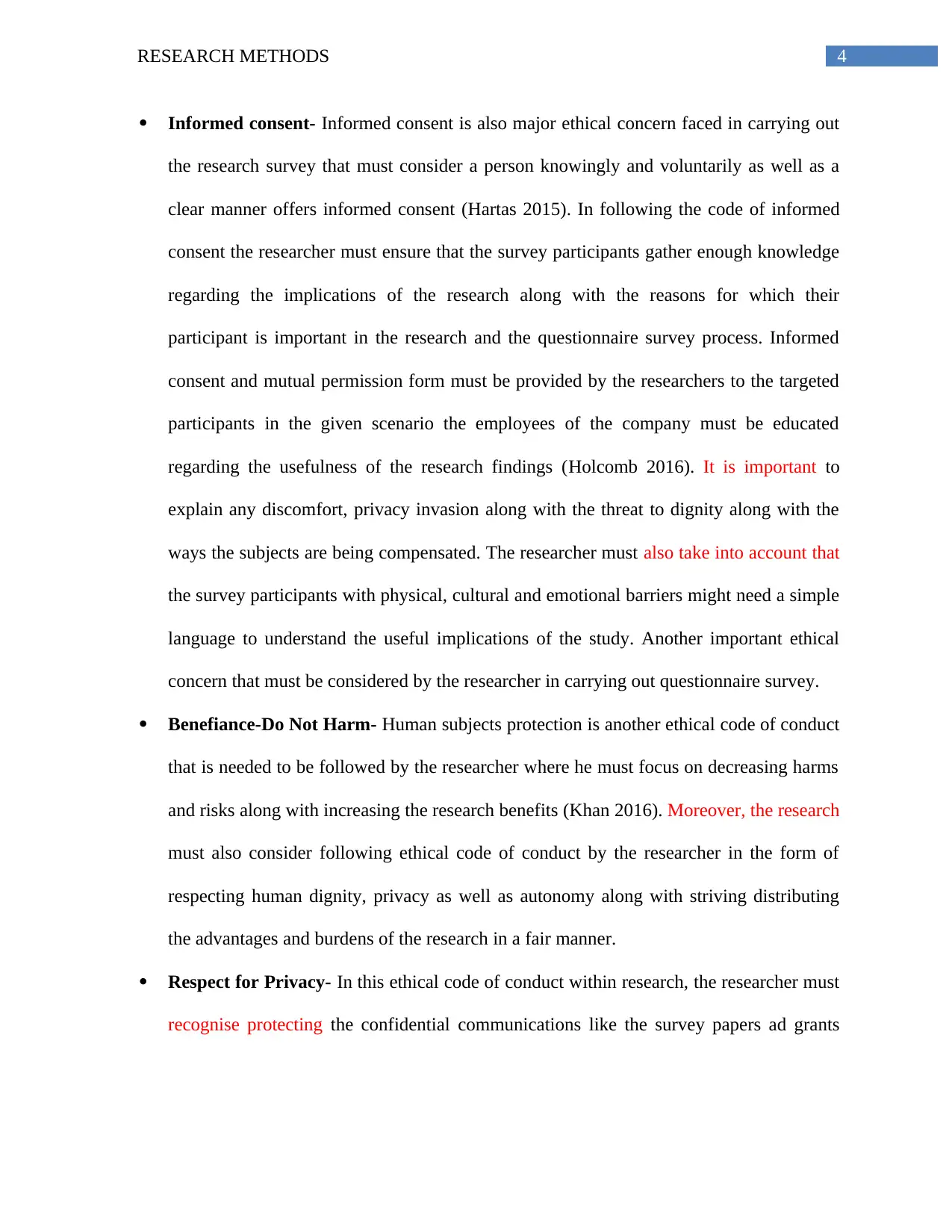
4RESEARCH METHODS
Informed consent- Informed consent is also major ethical concern faced in carrying out
the research survey that must consider a person knowingly and voluntarily as well as a
clear manner offers informed consent (Hartas 2015). In following the code of informed
consent the researcher must ensure that the survey participants gather enough knowledge
regarding the implications of the research along with the reasons for which their
participant is important in the research and the questionnaire survey process. Informed
consent and mutual permission form must be provided by the researchers to the targeted
participants in the given scenario the employees of the company must be educated
regarding the usefulness of the research findings (Holcomb 2016). It is important to
explain any discomfort, privacy invasion along with the threat to dignity along with the
ways the subjects are being compensated. The researcher must also take into account that
the survey participants with physical, cultural and emotional barriers might need a simple
language to understand the useful implications of the study. Another important ethical
concern that must be considered by the researcher in carrying out questionnaire survey.
Benefiance-Do Not Harm- Human subjects protection is another ethical code of conduct
that is needed to be followed by the researcher where he must focus on decreasing harms
and risks along with increasing the research benefits (Khan 2016). Moreover, the research
must also consider following ethical code of conduct by the researcher in the form of
respecting human dignity, privacy as well as autonomy along with striving distributing
the advantages and burdens of the research in a fair manner.
Respect for Privacy- In this ethical code of conduct within research, the researcher must
recognise protecting the confidential communications like the survey papers ad grants
Informed consent- Informed consent is also major ethical concern faced in carrying out
the research survey that must consider a person knowingly and voluntarily as well as a
clear manner offers informed consent (Hartas 2015). In following the code of informed
consent the researcher must ensure that the survey participants gather enough knowledge
regarding the implications of the research along with the reasons for which their
participant is important in the research and the questionnaire survey process. Informed
consent and mutual permission form must be provided by the researchers to the targeted
participants in the given scenario the employees of the company must be educated
regarding the usefulness of the research findings (Holcomb 2016). It is important to
explain any discomfort, privacy invasion along with the threat to dignity along with the
ways the subjects are being compensated. The researcher must also take into account that
the survey participants with physical, cultural and emotional barriers might need a simple
language to understand the useful implications of the study. Another important ethical
concern that must be considered by the researcher in carrying out questionnaire survey.
Benefiance-Do Not Harm- Human subjects protection is another ethical code of conduct
that is needed to be followed by the researcher where he must focus on decreasing harms
and risks along with increasing the research benefits (Khan 2016). Moreover, the research
must also consider following ethical code of conduct by the researcher in the form of
respecting human dignity, privacy as well as autonomy along with striving distributing
the advantages and burdens of the research in a fair manner.
Respect for Privacy- In this ethical code of conduct within research, the researcher must
recognise protecting the confidential communications like the survey papers ad grants
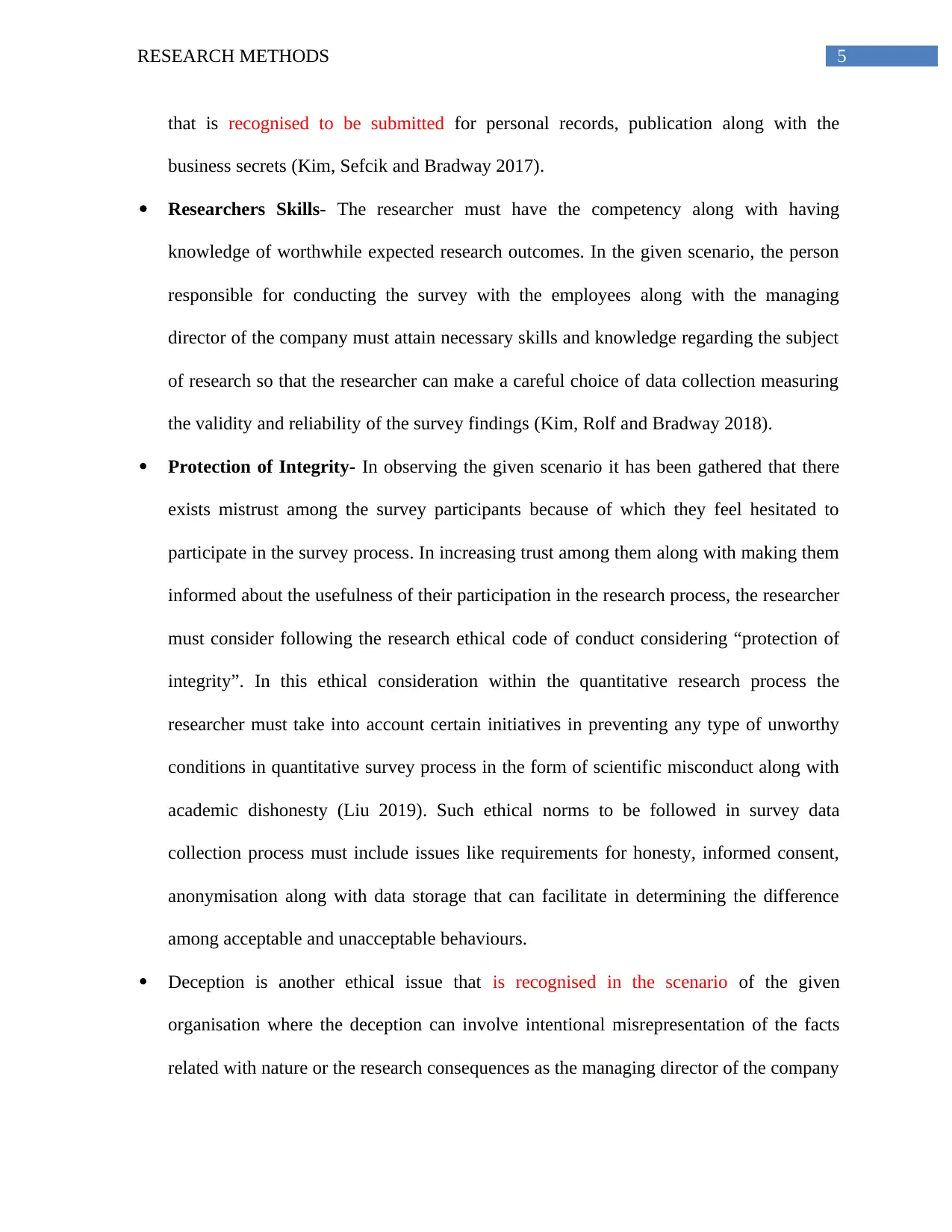
5RESEARCH METHODS
that is recognised to be submitted for personal records, publication along with the
business secrets (Kim, Sefcik and Bradway 2017).
Researchers Skills- The researcher must have the competency along with having
knowledge of worthwhile expected research outcomes. In the given scenario, the person
responsible for conducting the survey with the employees along with the managing
director of the company must attain necessary skills and knowledge regarding the subject
of research so that the researcher can make a careful choice of data collection measuring
the validity and reliability of the survey findings (Kim, Rolf and Bradway 2018).
Protection of Integrity- In observing the given scenario it has been gathered that there
exists mistrust among the survey participants because of which they feel hesitated to
participate in the survey process. In increasing trust among them along with making them
informed about the usefulness of their participation in the research process, the researcher
must consider following the research ethical code of conduct considering “protection of
integrity”. In this ethical consideration within the quantitative research process the
researcher must take into account certain initiatives in preventing any type of unworthy
conditions in quantitative survey process in the form of scientific misconduct along with
academic dishonesty (Liu 2019). Such ethical norms to be followed in survey data
collection process must include issues like requirements for honesty, informed consent,
anonymisation along with data storage that can facilitate in determining the difference
among acceptable and unacceptable behaviours.
Deception is another ethical issue that is recognised in the scenario of the given
organisation where the deception can involve intentional misrepresentation of the facts
related with nature or the research consequences as the managing director of the company
that is recognised to be submitted for personal records, publication along with the
business secrets (Kim, Sefcik and Bradway 2017).
Researchers Skills- The researcher must have the competency along with having
knowledge of worthwhile expected research outcomes. In the given scenario, the person
responsible for conducting the survey with the employees along with the managing
director of the company must attain necessary skills and knowledge regarding the subject
of research so that the researcher can make a careful choice of data collection measuring
the validity and reliability of the survey findings (Kim, Rolf and Bradway 2018).
Protection of Integrity- In observing the given scenario it has been gathered that there
exists mistrust among the survey participants because of which they feel hesitated to
participate in the survey process. In increasing trust among them along with making them
informed about the usefulness of their participation in the research process, the researcher
must consider following the research ethical code of conduct considering “protection of
integrity”. In this ethical consideration within the quantitative research process the
researcher must take into account certain initiatives in preventing any type of unworthy
conditions in quantitative survey process in the form of scientific misconduct along with
academic dishonesty (Liu 2019). Such ethical norms to be followed in survey data
collection process must include issues like requirements for honesty, informed consent,
anonymisation along with data storage that can facilitate in determining the difference
among acceptable and unacceptable behaviours.
Deception is another ethical issue that is recognised in the scenario of the given
organisation where the deception can involve intentional misrepresentation of the facts
related with nature or the research consequences as the managing director of the company
⊘ This is a preview!⊘
Do you want full access?
Subscribe today to unlock all pages.

Trusted by 1+ million students worldwide
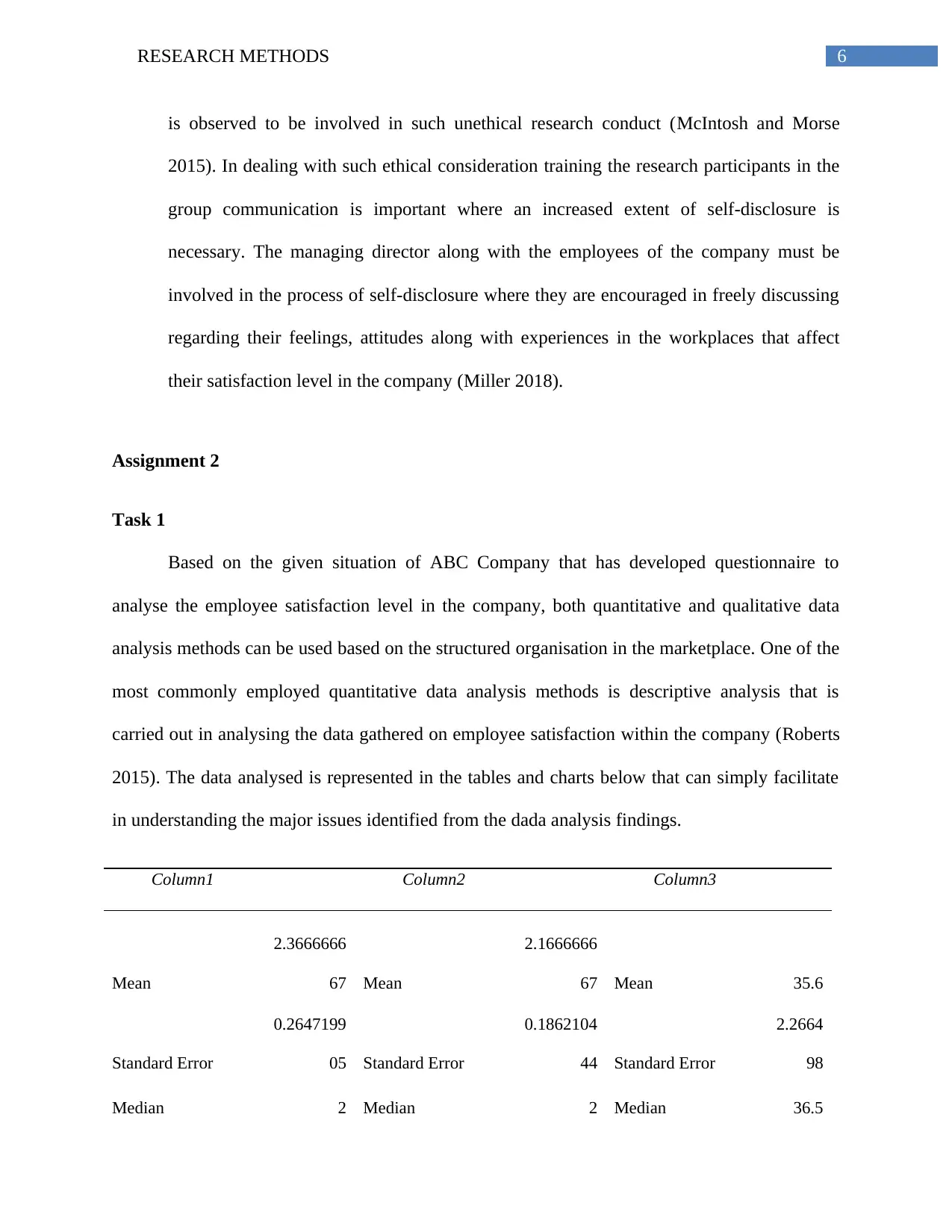
6RESEARCH METHODS
is observed to be involved in such unethical research conduct (McIntosh and Morse
2015). In dealing with such ethical consideration training the research participants in the
group communication is important where an increased extent of self-disclosure is
necessary. The managing director along with the employees of the company must be
involved in the process of self-disclosure where they are encouraged in freely discussing
regarding their feelings, attitudes along with experiences in the workplaces that affect
their satisfaction level in the company (Miller 2018).
Assignment 2
Task 1
Based on the given situation of ABC Company that has developed questionnaire to
analyse the employee satisfaction level in the company, both quantitative and qualitative data
analysis methods can be used based on the structured organisation in the marketplace. One of the
most commonly employed quantitative data analysis methods is descriptive analysis that is
carried out in analysing the data gathered on employee satisfaction within the company (Roberts
2015). The data analysed is represented in the tables and charts below that can simply facilitate
in understanding the major issues identified from the dada analysis findings.
Column1 Column2 Column3
Mean
2.3666666
67 Mean
2.1666666
67 Mean 35.6
Standard Error
0.2647199
05 Standard Error
0.1862104
44 Standard Error
2.2664
98
Median 2 Median 2 Median 36.5
is observed to be involved in such unethical research conduct (McIntosh and Morse
2015). In dealing with such ethical consideration training the research participants in the
group communication is important where an increased extent of self-disclosure is
necessary. The managing director along with the employees of the company must be
involved in the process of self-disclosure where they are encouraged in freely discussing
regarding their feelings, attitudes along with experiences in the workplaces that affect
their satisfaction level in the company (Miller 2018).
Assignment 2
Task 1
Based on the given situation of ABC Company that has developed questionnaire to
analyse the employee satisfaction level in the company, both quantitative and qualitative data
analysis methods can be used based on the structured organisation in the marketplace. One of the
most commonly employed quantitative data analysis methods is descriptive analysis that is
carried out in analysing the data gathered on employee satisfaction within the company (Roberts
2015). The data analysed is represented in the tables and charts below that can simply facilitate
in understanding the major issues identified from the dada analysis findings.
Column1 Column2 Column3
Mean
2.3666666
67 Mean
2.1666666
67 Mean 35.6
Standard Error
0.2647199
05 Standard Error
0.1862104
44 Standard Error
2.2664
98
Median 2 Median 2 Median 36.5
Paraphrase This Document
Need a fresh take? Get an instant paraphrase of this document with our AI Paraphraser
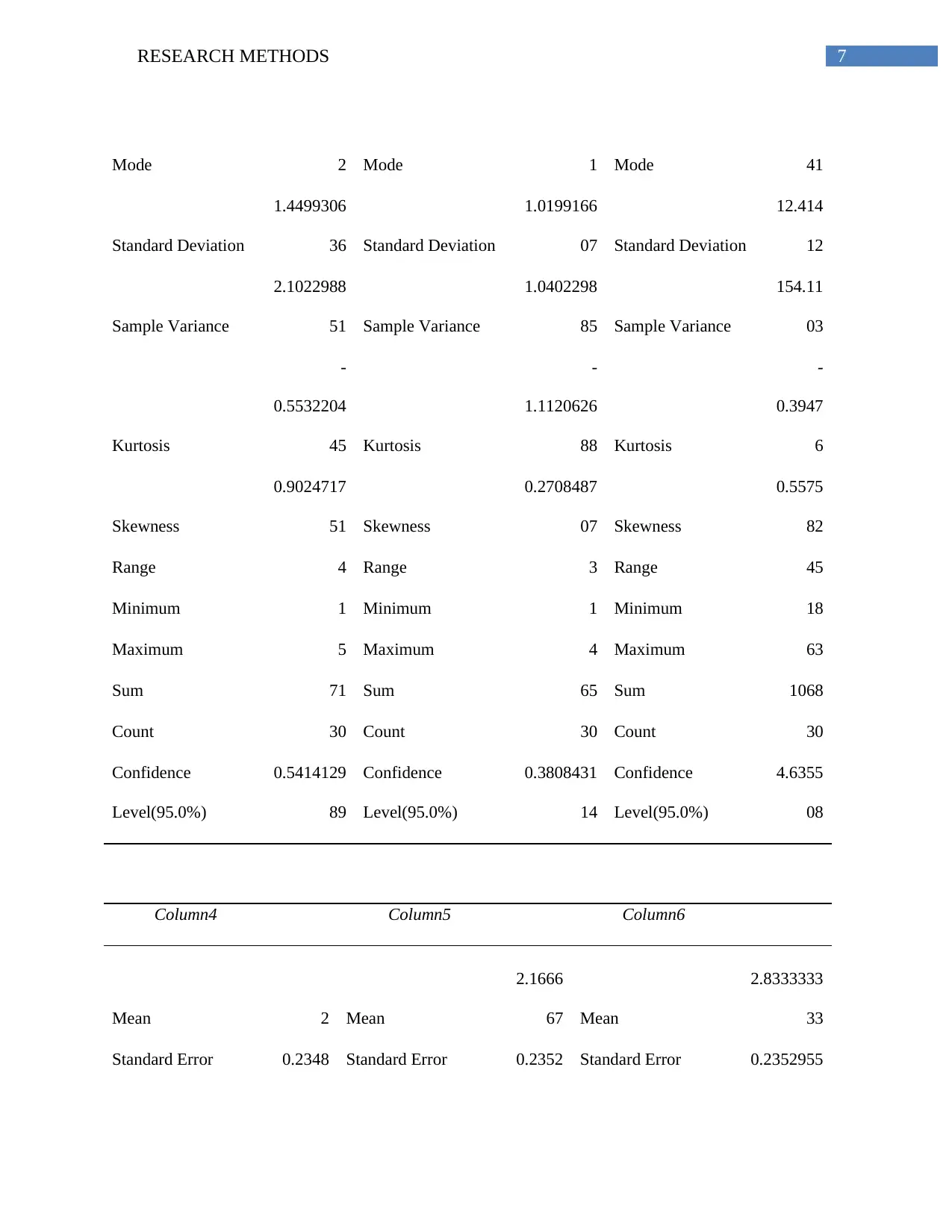
7RESEARCH METHODS
Mode 2 Mode 1 Mode 41
Standard Deviation
1.4499306
36 Standard Deviation
1.0199166
07 Standard Deviation
12.414
12
Sample Variance
2.1022988
51 Sample Variance
1.0402298
85 Sample Variance
154.11
03
Kurtosis
-
0.5532204
45 Kurtosis
-
1.1120626
88 Kurtosis
-
0.3947
6
Skewness
0.9024717
51 Skewness
0.2708487
07 Skewness
0.5575
82
Range 4 Range 3 Range 45
Minimum 1 Minimum 1 Minimum 18
Maximum 5 Maximum 4 Maximum 63
Sum 71 Sum 65 Sum 1068
Count 30 Count 30 Count 30
Confidence
Level(95.0%)
0.5414129
89
Confidence
Level(95.0%)
0.3808431
14
Confidence
Level(95.0%)
4.6355
08
Column4 Column5 Column6
Mean 2 Mean
2.1666
67 Mean
2.8333333
33
Standard Error 0.2348 Standard Error 0.2352 Standard Error 0.2352955
Mode 2 Mode 1 Mode 41
Standard Deviation
1.4499306
36 Standard Deviation
1.0199166
07 Standard Deviation
12.414
12
Sample Variance
2.1022988
51 Sample Variance
1.0402298
85 Sample Variance
154.11
03
Kurtosis
-
0.5532204
45 Kurtosis
-
1.1120626
88 Kurtosis
-
0.3947
6
Skewness
0.9024717
51 Skewness
0.2708487
07 Skewness
0.5575
82
Range 4 Range 3 Range 45
Minimum 1 Minimum 1 Minimum 18
Maximum 5 Maximum 4 Maximum 63
Sum 71 Sum 65 Sum 1068
Count 30 Count 30 Count 30
Confidence
Level(95.0%)
0.5414129
89
Confidence
Level(95.0%)
0.3808431
14
Confidence
Level(95.0%)
4.6355
08
Column4 Column5 Column6
Mean 2 Mean
2.1666
67 Mean
2.8333333
33
Standard Error 0.2348 Standard Error 0.2352 Standard Error 0.2352955
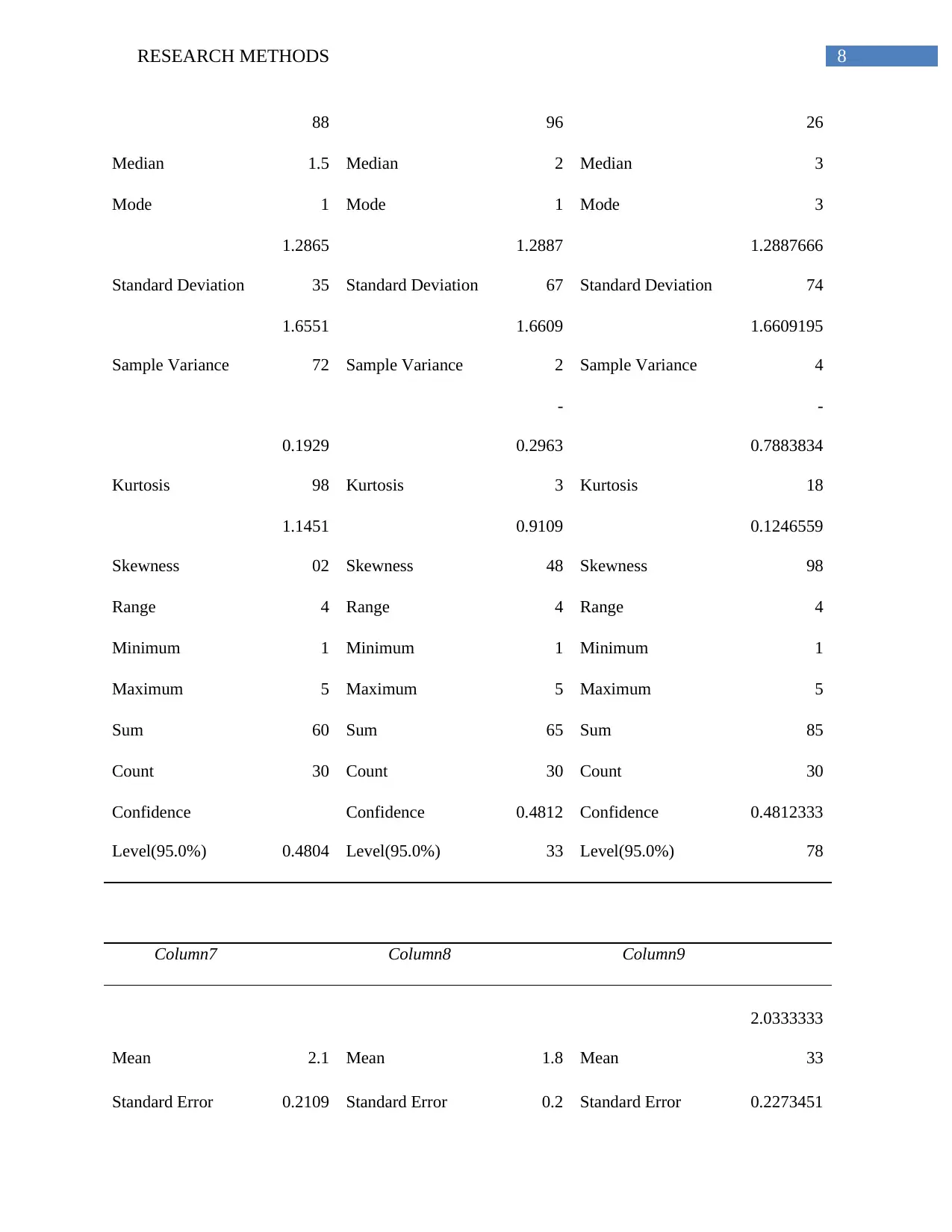
8RESEARCH METHODS
88 96 26
Median 1.5 Median 2 Median 3
Mode 1 Mode 1 Mode 3
Standard Deviation
1.2865
35 Standard Deviation
1.2887
67 Standard Deviation
1.2887666
74
Sample Variance
1.6551
72 Sample Variance
1.6609
2 Sample Variance
1.6609195
4
Kurtosis
0.1929
98 Kurtosis
-
0.2963
3 Kurtosis
-
0.7883834
18
Skewness
1.1451
02 Skewness
0.9109
48 Skewness
0.1246559
98
Range 4 Range 4 Range 4
Minimum 1 Minimum 1 Minimum 1
Maximum 5 Maximum 5 Maximum 5
Sum 60 Sum 65 Sum 85
Count 30 Count 30 Count 30
Confidence
Level(95.0%) 0.4804
Confidence
Level(95.0%)
0.4812
33
Confidence
Level(95.0%)
0.4812333
78
Column7 Column8 Column9
Mean 2.1 Mean 1.8 Mean
2.0333333
33
Standard Error 0.2109 Standard Error 0.2 Standard Error 0.2273451
88 96 26
Median 1.5 Median 2 Median 3
Mode 1 Mode 1 Mode 3
Standard Deviation
1.2865
35 Standard Deviation
1.2887
67 Standard Deviation
1.2887666
74
Sample Variance
1.6551
72 Sample Variance
1.6609
2 Sample Variance
1.6609195
4
Kurtosis
0.1929
98 Kurtosis
-
0.2963
3 Kurtosis
-
0.7883834
18
Skewness
1.1451
02 Skewness
0.9109
48 Skewness
0.1246559
98
Range 4 Range 4 Range 4
Minimum 1 Minimum 1 Minimum 1
Maximum 5 Maximum 5 Maximum 5
Sum 60 Sum 65 Sum 85
Count 30 Count 30 Count 30
Confidence
Level(95.0%) 0.4804
Confidence
Level(95.0%)
0.4812
33
Confidence
Level(95.0%)
0.4812333
78
Column7 Column8 Column9
Mean 2.1 Mean 1.8 Mean
2.0333333
33
Standard Error 0.2109 Standard Error 0.2 Standard Error 0.2273451
⊘ This is a preview!⊘
Do you want full access?
Subscribe today to unlock all pages.

Trusted by 1+ million students worldwide
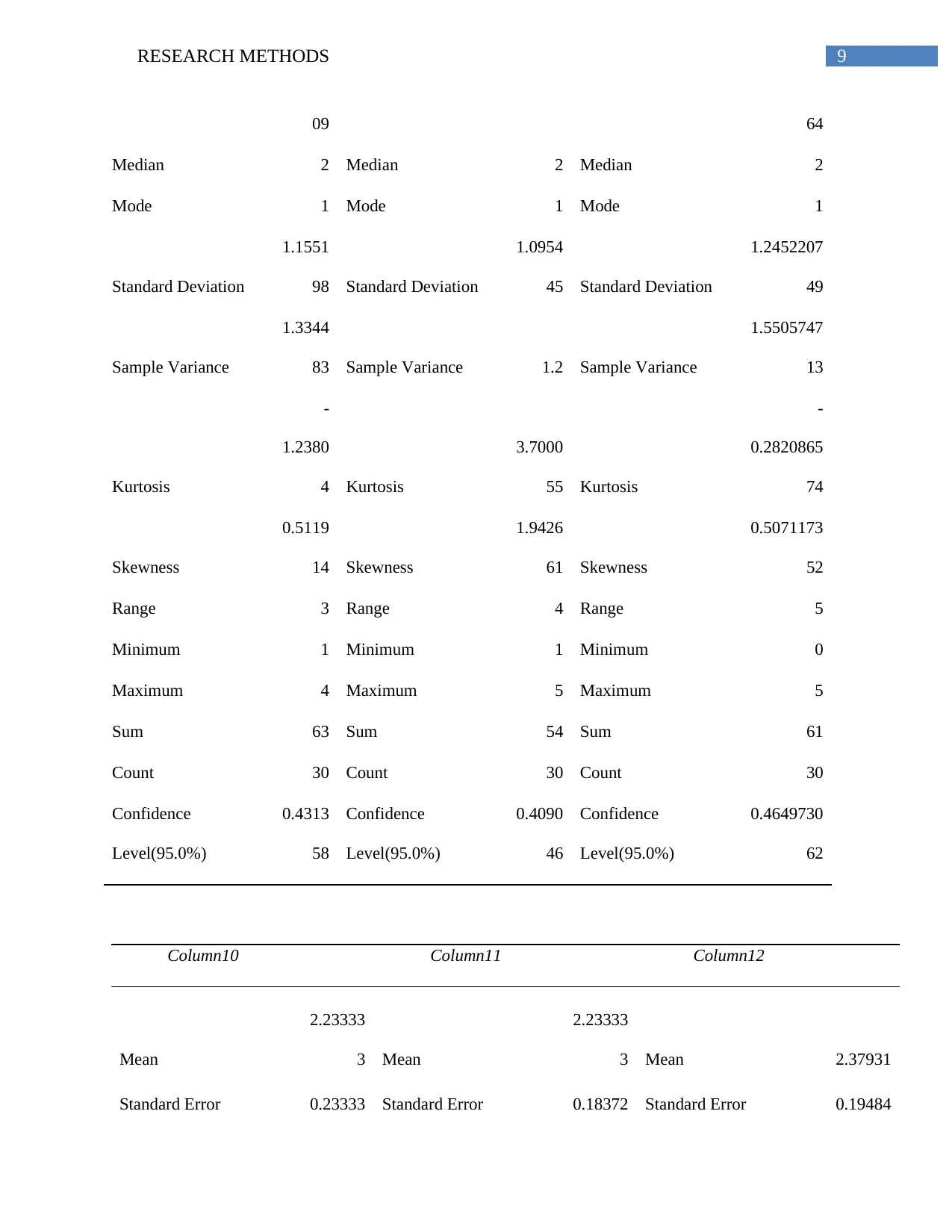
9RESEARCH METHODS
09 64
Median 2 Median 2 Median 2
Mode 1 Mode 1 Mode 1
Standard Deviation
1.1551
98 Standard Deviation
1.0954
45 Standard Deviation
1.2452207
49
Sample Variance
1.3344
83 Sample Variance 1.2 Sample Variance
1.5505747
13
Kurtosis
-
1.2380
4 Kurtosis
3.7000
55 Kurtosis
-
0.2820865
74
Skewness
0.5119
14 Skewness
1.9426
61 Skewness
0.5071173
52
Range 3 Range 4 Range 5
Minimum 1 Minimum 1 Minimum 0
Maximum 4 Maximum 5 Maximum 5
Sum 63 Sum 54 Sum 61
Count 30 Count 30 Count 30
Confidence
Level(95.0%)
0.4313
58
Confidence
Level(95.0%)
0.4090
46
Confidence
Level(95.0%)
0.4649730
62
Column10 Column11 Column12
Mean
2.23333
3 Mean
2.23333
3 Mean 2.37931
Standard Error 0.23333 Standard Error 0.18372 Standard Error 0.19484
09 64
Median 2 Median 2 Median 2
Mode 1 Mode 1 Mode 1
Standard Deviation
1.1551
98 Standard Deviation
1.0954
45 Standard Deviation
1.2452207
49
Sample Variance
1.3344
83 Sample Variance 1.2 Sample Variance
1.5505747
13
Kurtosis
-
1.2380
4 Kurtosis
3.7000
55 Kurtosis
-
0.2820865
74
Skewness
0.5119
14 Skewness
1.9426
61 Skewness
0.5071173
52
Range 3 Range 4 Range 5
Minimum 1 Minimum 1 Minimum 0
Maximum 4 Maximum 5 Maximum 5
Sum 63 Sum 54 Sum 61
Count 30 Count 30 Count 30
Confidence
Level(95.0%)
0.4313
58
Confidence
Level(95.0%)
0.4090
46
Confidence
Level(95.0%)
0.4649730
62
Column10 Column11 Column12
Mean
2.23333
3 Mean
2.23333
3 Mean 2.37931
Standard Error 0.23333 Standard Error 0.18372 Standard Error 0.19484
Paraphrase This Document
Need a fresh take? Get an instant paraphrase of this document with our AI Paraphraser
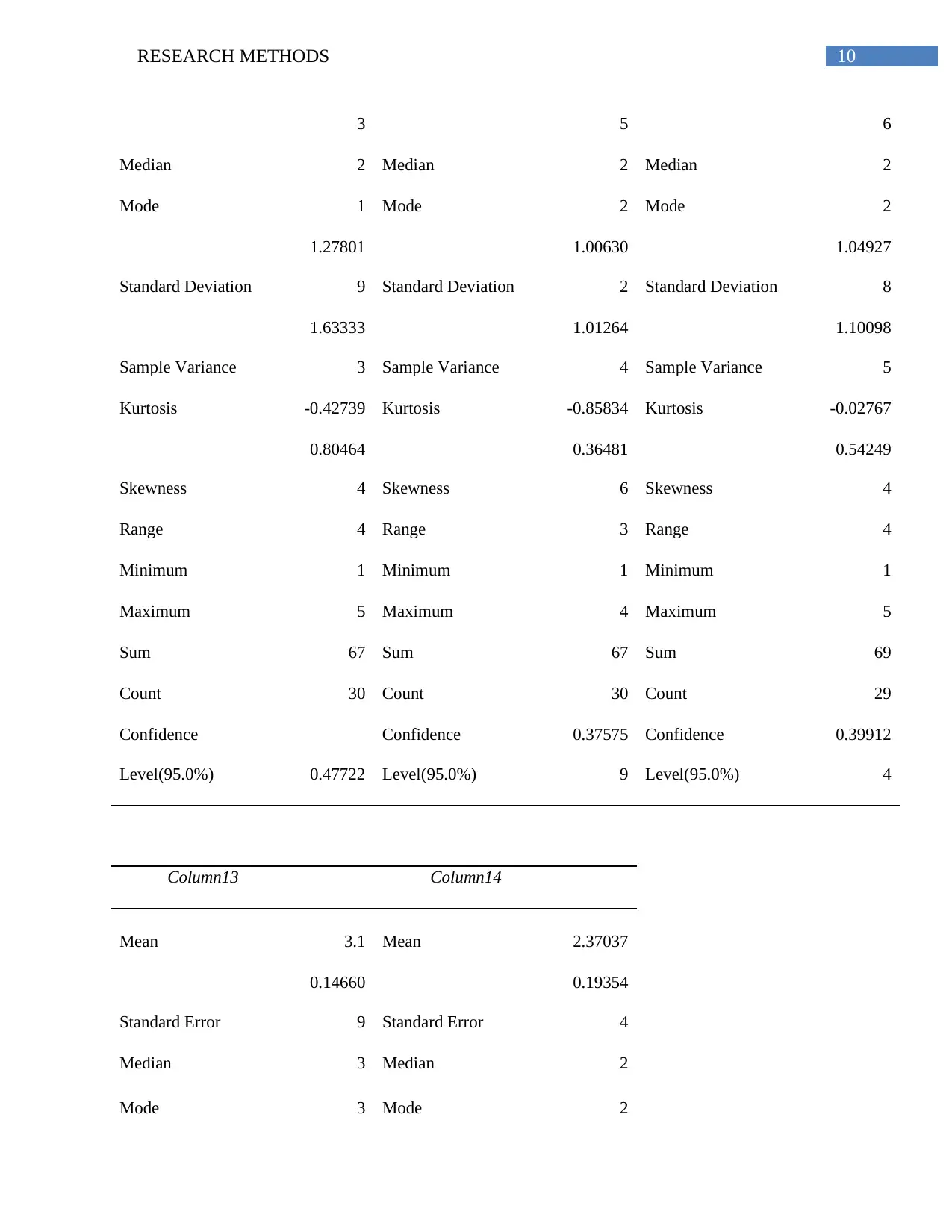
10RESEARCH METHODS
3 5 6
Median 2 Median 2 Median 2
Mode 1 Mode 2 Mode 2
Standard Deviation
1.27801
9 Standard Deviation
1.00630
2 Standard Deviation
1.04927
8
Sample Variance
1.63333
3 Sample Variance
1.01264
4 Sample Variance
1.10098
5
Kurtosis -0.42739 Kurtosis -0.85834 Kurtosis -0.02767
Skewness
0.80464
4 Skewness
0.36481
6 Skewness
0.54249
4
Range 4 Range 3 Range 4
Minimum 1 Minimum 1 Minimum 1
Maximum 5 Maximum 4 Maximum 5
Sum 67 Sum 67 Sum 69
Count 30 Count 30 Count 29
Confidence
Level(95.0%) 0.47722
Confidence
Level(95.0%)
0.37575
9
Confidence
Level(95.0%)
0.39912
4
Column13 Column14
Mean 3.1 Mean 2.37037
Standard Error
0.14660
9 Standard Error
0.19354
4
Median 3 Median 2
Mode 3 Mode 2
3 5 6
Median 2 Median 2 Median 2
Mode 1 Mode 2 Mode 2
Standard Deviation
1.27801
9 Standard Deviation
1.00630
2 Standard Deviation
1.04927
8
Sample Variance
1.63333
3 Sample Variance
1.01264
4 Sample Variance
1.10098
5
Kurtosis -0.42739 Kurtosis -0.85834 Kurtosis -0.02767
Skewness
0.80464
4 Skewness
0.36481
6 Skewness
0.54249
4
Range 4 Range 3 Range 4
Minimum 1 Minimum 1 Minimum 1
Maximum 5 Maximum 4 Maximum 5
Sum 67 Sum 67 Sum 69
Count 30 Count 30 Count 29
Confidence
Level(95.0%) 0.47722
Confidence
Level(95.0%)
0.37575
9
Confidence
Level(95.0%)
0.39912
4
Column13 Column14
Mean 3.1 Mean 2.37037
Standard Error
0.14660
9 Standard Error
0.19354
4
Median 3 Median 2
Mode 3 Mode 2
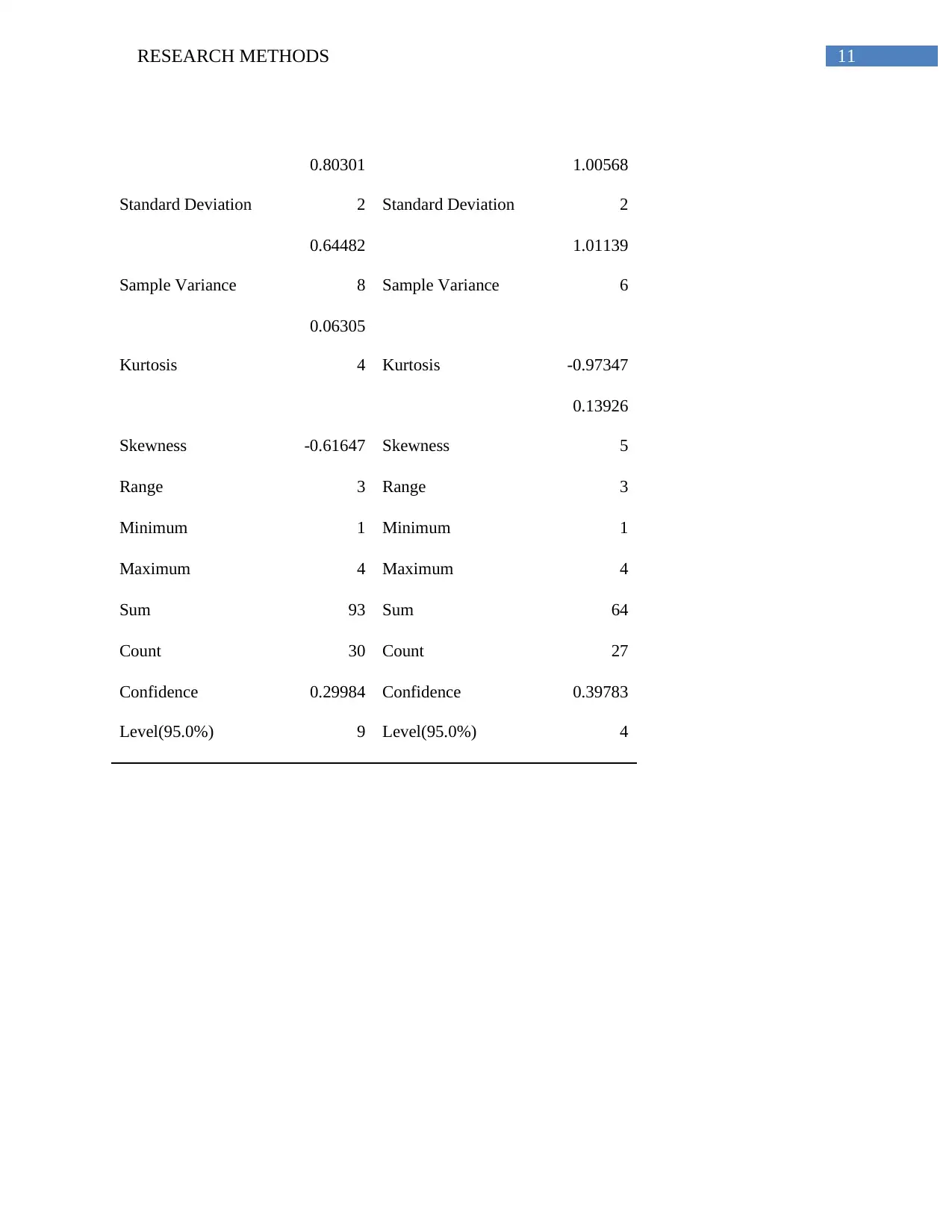
11RESEARCH METHODS
Standard Deviation
0.80301
2 Standard Deviation
1.00568
2
Sample Variance
0.64482
8 Sample Variance
1.01139
6
Kurtosis
0.06305
4 Kurtosis -0.97347
Skewness -0.61647 Skewness
0.13926
5
Range 3 Range 3
Minimum 1 Minimum 1
Maximum 4 Maximum 4
Sum 93 Sum 64
Count 30 Count 27
Confidence
Level(95.0%)
0.29984
9
Confidence
Level(95.0%)
0.39783
4
Standard Deviation
0.80301
2 Standard Deviation
1.00568
2
Sample Variance
0.64482
8 Sample Variance
1.01139
6
Kurtosis
0.06305
4 Kurtosis -0.97347
Skewness -0.61647 Skewness
0.13926
5
Range 3 Range 3
Minimum 1 Minimum 1
Maximum 4 Maximum 4
Sum 93 Sum 64
Count 30 Count 27
Confidence
Level(95.0%)
0.29984
9
Confidence
Level(95.0%)
0.39783
4
⊘ This is a preview!⊘
Do you want full access?
Subscribe today to unlock all pages.

Trusted by 1+ million students worldwide
1 out of 31
Related Documents
Your All-in-One AI-Powered Toolkit for Academic Success.
+13062052269
info@desklib.com
Available 24*7 on WhatsApp / Email
![[object Object]](/_next/static/media/star-bottom.7253800d.svg)
Unlock your academic potential
Copyright © 2020–2025 A2Z Services. All Rights Reserved. Developed and managed by ZUCOL.





